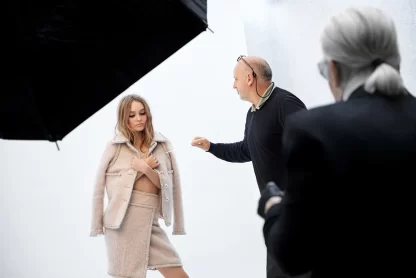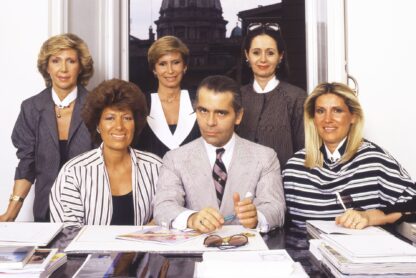On December 16, 1946, Christian Dior founded his eponymous house at 30, Avenue Montaigne in Paris. In just under 3 months, the French couturier curated a collection that would soon change women’s fashion forever: The New Look.
From nearly 22 haute couture collections that he designed the New Look was his most famous. Therefore, today, we wanted to share with you the history and evolution of Christian Dior’s New Look.

The History and Evolution of Christian Dior’s New Look
When was the New Look created?
On February 12, 1947, Christian Dior unveiled his debut collection, Spring-Summer 1947 at his salons at 30, Avenue Montaigne. The collection comprised 90 looks, and the most iconic one was the renowned “New Look”.

Why is “The New Look” called like that?
The Spring-Summer 1947 collection featured two lines, called “Corolle” and “En Huit.” However, the collection went down in fashion history as “The New Look” after an encounter with Carmel Snow, editor-in-chief of Harper’s Bazaar. She was the first to rush backstage to congratulate Monsieur Dior on his debut show: “It’s quite a revolution, dear Christian! Your dresses have such a new look.” Her catchphrase inspired the famous name “New Look”.

What is Dior’s New Look comprised of?
Christian Dior’s New Look consists of a few recognizable elements. It has a fitted bodice with a cinched waist and a full skirt underlying the curves, falling below the knees.
The ensemble was accessorized with elongated gloves, kitten-heel pumps, and a graceful hat.
Why is Christian Dior’s New Look so famous?
Showcasing at the end of World War 2, Monsieur Dior’s New Look was groundbreaking and much ahead of its time. The fashion world had never seen such elaborate designs, using an abundance of fabric. It was indeed unheard of to use so much fabric during the severe rationing that the country was still facing after the war. Therefore, the collection wasn’t received well by everyone, and some critics prompted a severe backlash.
Nonetheless, Christian Dior was driven by a dream. He wanted to celebrate life after the war and embrace women’s beauty and feminity. He encouraged them to feel joy and dress extravagantly again. His New Look was in sharp contrast with the utilitarian garments that women wore during the 1940s, marking a new departure for women’s fashion.
This is how Dior described his vision for his “New Look” collection, according to TIME magazine’s 1957 cover story on the fashion designer, “‘We were leaving a period of war, of uniforms, of soldier-women with shoulders like boxers. I turned them into flowers, with soft shoulders, blooming bosoms, waists slim as vine stems, and skirts opening up like blossoms.’”
Christian Dior’s Collection and Natural Pride
What’s also notable about Christian Dior’s collection, besides the beauty and originality of the designs, was the significant role it played in restoring national pride and in “the redefinition of a country and a culture through fashion,” according to an article by the Washington Post. Florence Muller, a prominent fashion historian said about Christian Dior that “He was a reactionary, who reinvented national pride after a terrible moment.”
Vogue also noted the couturier’s efforts in its April 1947 issue: “The opening of Christian Dior’s new Paris couture house, not only presented an extraordinarily beautiful collection; it gave the French couture a new assurance in its own abilities; and because the luxury trades are economic necessity in France, Dior’s flashing success was, in Paris, more than fashion. It was on a par with current political and economic news. Here—once again—things were done on a grand scale.”
The New Look and the British Royal Family
The New Look became one of the brand’s signature looks and took the designer’s career to the next level. The distinguished fashion house became inundated with orders and desire for the pieces.
With a striking rise of significance in the fashion industry, Dior was even invited to host a private fashion show for the British royal family, at the request of the Queen (the late Queen Mother) and Princesses Elizabeth and Margaret at the French Embassy in London in April 1950. Princess Margaret particularly admired Dior’s work, so he had the honor to dress her for her 21st birthday.

© Cecil Beaton, Victoria and Albert Museum, London
The evolution of Dior’s Bar Jacket
Let’s take a closer look at a central piece from Christian Dior’s debut collection: The Bar Suit. The cinched-waisted silhouette was achieved thanks to the Bar Jacket, and it is considered the most iconic model in the collection.
Fun fact: Apparently, the Bar jacket took its name from the bar at the Plaza Athénée in Paris, which Christian Dior frequented.

Dior’s Bar Jacket has been the house’s signature piece since day one. The founder constantly looks for perfecting and updating one of his favorite garments, which was presented in various versions in almost all of the 22 couture collections he designed until his sudden death in 1957.
Since then, there have been various interpretation of the Bar Jacket.
During Yves Saint Laurent’s years at Dior, where he served as creative director from 1957 until 1960, the Bar Jacket was put on hold since he introduced a new silhouette – the Trapèze line.
Dior Bar Jacket by Marc Bohan
The iconic piece made a triumphant return when Marc Bohan succeeded YSL in 1960 and remained at Maison Dior’s helm until 1989. His first “Slim Look” collection for spring 1961 had feminine and soft takes on the Bar Jacket.

Dior Bar Jacket by Gianfranco Ferré
Gianfranco Ferré, who served as Dior’s creative director from 1989 to 1997, modernized the Bar Jacket with a more exuberant style that reflected fashion at that time. His variations of the Bar Jacket silhouette expanded into dresses with maxi sleeves and a cinched waist.

Dior Bar Jacket by John Galliano
When John Galliano arrived at the house, (1997-2011) his collections were even more dramatic and exuberant, and so was his Bar Jacket.

Dior Bar Jacket by Raf Simons
Raf Simons (2012-2016) returned to the Bar Jacket’s roots. He paid homage to Christian Dior’s love for architecture and embraced elegance with a modern, playful twist.

Dior Bar Jacket by Maria Grazia Chiuri
In 2016, Maria Grazia Chiuri became the first woman to lead the couture house and maintained her predecessor’s elegant take on the Bar Jacket and made it even more feminine. She included the piece in nearly all of her collections.

Christian Dior’s New Look has had a long life. Throughout the years, Dior’s creative directors used many ways to reimagine the central piece of the look – the Bar Jacket. In the creative and innovative world of fashion, we will for sure see its new reinterpretations in the future.
If you want to learn more about the origins of Christian Dior, the series “New Look” is already available on Apple TV.
Follow the Glam Observer on Instagram today!







I would love to come to Dior and take a tour……Do they give complimentary trips ? I have a personal reason ….My name is Stephanie Dior.